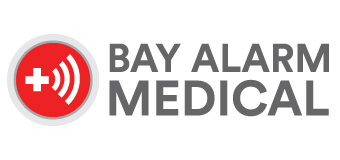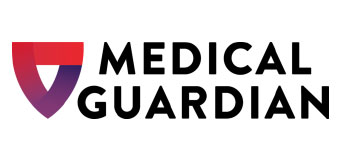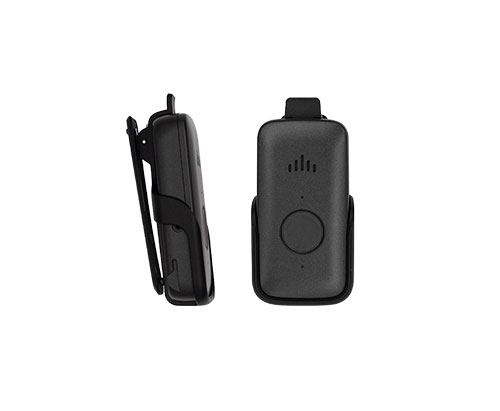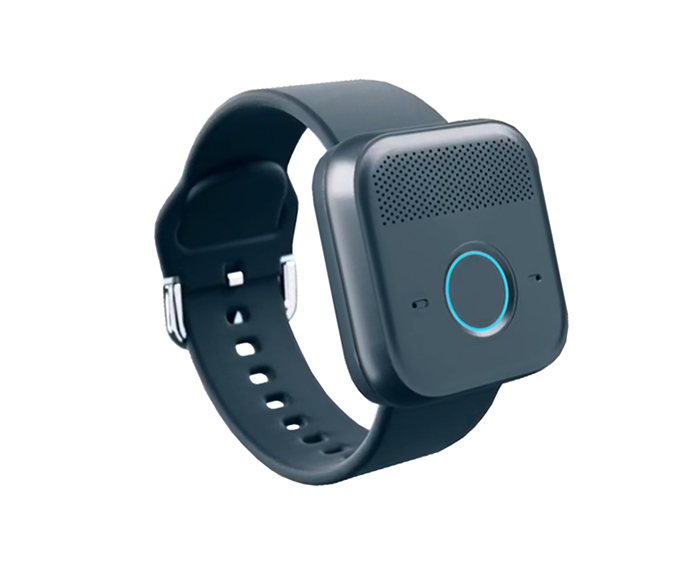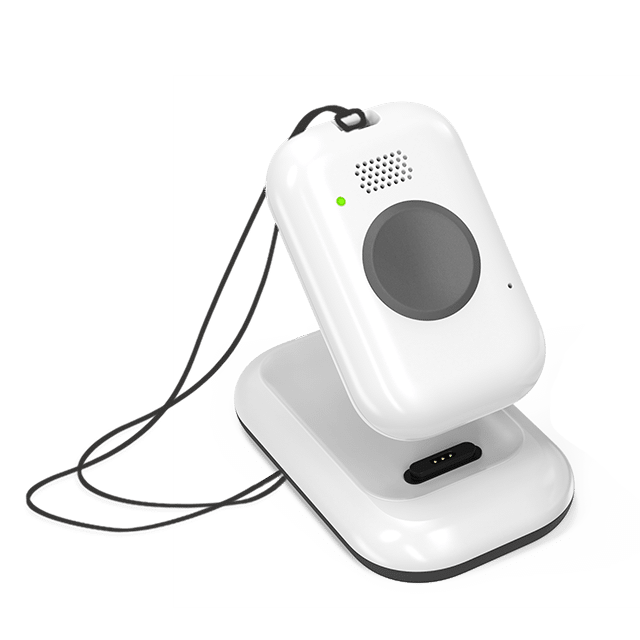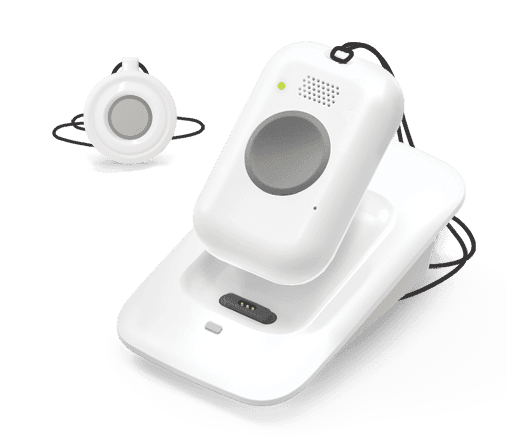MedicalAlertBuyersGuide.org is an independent review site. We may earn money when you click on links on our site. Learn More

What Is a Mobile Medical Alert System?
A mobile medical alert system is a compact medical alert device that connects users to a helpline in case of a medical or other emergency via cellular service. Like a mobile phone, you can take the medical alert system with you wherever you go, so long as you stay in an area with good cell coverage.
Mobile medical alerts are a good choice for seniors who aren’t homebound. They provide an enhanced level of safety while you move around town, walk around the neighborhood, or simplyspend time in your yard. They work anywhere in the United States that has cellular coverage.
Mobile medical alerts are standalone systems designed to work without an existing mobile phone. This makes them different from many of the “no fee” medical alerts on the market. A true mobile medical alert system includes a monthly service fee that pays for both cellular service and 24/7 emergency operators who monitor your device and respond in case of an emergency.
Why Choose a Mobile Medical Alert?
According to a survey by AARP, it is getting harder for families to manage care for aging relatives. Mobile medical alert systems may help. Besides their compact size and mobility, mobile medical alert systems typically include three features that aren’t found in traditional in-home medical alert systems:
- Automatic Fall Detection
- GPS Tracking
- Caregiver Tracking
These features may make it possible for older adults to stay independent longer and help caregivers keep their loved ones safe.
Automatic fall detection is a key feature of a mobile medical alert systems.Traditional medical alert devices require the wearer to push a button in an emergency. But that may not be possible if a fall incapacitates the wearer due to a head injury or other issue. Automatic fall detection is an important safeguard against this. Note the fall detection is typically an optional feature for a small extra monthly fee. We think this feature is well worth it.
GPS tracking allows your medical alert monitoring company to know your location and communicate that to emergency responders. Emergency operators can give your exact address or latitude and longitude coordinates if you are in a park or other location without a street address.
Caregiver tracking allows people you trust to log into an online portal and view your location at any time, whether during an emergency or in daily life. This can be helpful if the person wearing the medical alert is prone to wandering due to dementia or Alzheimer’s disease.
Price Comparison, First Year Cost of Ownership
| Company | System | Startup Cost | Monitoring | Fall Detection | First Year Total Cost |
|---|---|---|---|---|---|
| Lifeline | On The Go | $129.90 | $49.95/month | $15.00/month | $909.30 |
| Medical Guardian | MGMini Lite | $162.45 | $44.95/month | $10.00/month | $821.85 |
| MedicalAlert.com | Mobile | $124.90 | $47.95/month | $10.00/month | $820.30 |
| Bay Alarm Medical | SOS Mobile | $69.30 | $34.95/month | $10.00/month | $620.70 |
| MobileHelp | Mirco | $0 | $39.95/month | $11.00/month | $611.40 |
| Lively | Mobile+ | $49.99 | $24.99/month | $9.99/month | $469.75 |
2 - First Year Total Cost assumes a monthly subscription plan with fall detection.
Mobile Medical Alerts vs. Medical Alert Watches
Mobile medical alerts are the second generation of medical alert systems. The first generation of personal emergency response systems (PERS) were in-home medical alerts that worked through your existing telephone line. Mobile systems break free of the home landline and work anywhere you might go in your daily life.
Today there is a growing trend toward a third generation of medical alert systems: medical alert smartwatches. If smartwatches are the newest breed of medical alert, why would you want a second-generation mobile medical alert?
The reasons are simple: price and automatic fall detection.
Medical alert watches are generally more expensive than mobile systems. In addition, mobile medical alerts have a mature implementation of automatic fall detection whereas medical alert watches still face challenges with fall detection. Indeed, at the time of writing, only Bay Alarm Medical has a smartwatch that is advanced enough to offer automatic fall detection.
We see compelling advantages to mobile medical alerts. We think this type of system is the best fit for most people seeking a medical alert system.
How We Chose the Best Mobile Medical Alert
To choose the best medical alert systems, our team performed over 350 hours of research and hands-on testing. We purchased all the medical alerts included in this review and evaluated all steps of the experience: from buying the system, to setting it up, and real-life testing, including simulating falls.
We focused not just on the technical aspects of the system, but also the quality of service provided by the vendor. We called sales teams to ask a standard set of questions, evaluating both the quality of their answers and the level of sales pitch included (pushy, high pressure sales tactics are a no-no). During our simulated falls, we even evaluated the interaction with those emergency operators who called to check on us.
Finally, we returned all of the systems after testing, asking for a timely refund. That allowed us to evaluate the fairness of each vendor’s return policy. For more information, read our disclosure page.
Disclosure: In order to provide this free service to our visitors, Medicalalertbuyersguide.org may receive compensation if a purchase is made through this website.
| SOS Mobile | |
|---|---|
| Device Cost: | $63.90 + $12.00 shipping |
| Shipping: | $12.00 |
| Monitoring Service: | $34.95/month |
| Fall Detection: | $10.00/month |
| Total 1-Year Cost: | $620.70 |
Bay Alarm Medical SOS Mobile
The SOS Mobile medical alert may be our favorite of Bay Alarm Medical’s systems, and it is our #1 pick for the Best Mobile Medical Alert System. The system provides manyfeatures at a fairly low price point, making it a good value.
While we don’t like the $99 hardware cost paid up-front, Bay Alarm Medical charges only $29.95 for monthly monitoring. That’s $20/month less than other companies charge for the same service. With an additional $10 per month for optional fall detection (something we highly recommend), that brings the first-year cost of owning the system to $578.40. Among the systems we tested, only Lively Mobile+ costs less than this.
The SOS Mobile offers a compact, sleek design, with the option to wear the device around your neck or on your hip. We like that automatic fall detection is integrated into the device and doesn’t require you to wear a separate pendant just for that optional feature. We found the automatic fall detection to work well, setting off alarms on hard falls but not triggering false alarms for minor bumps.
While we had some minor issues with the initial setup, everything else about the system was easy to use. We found its GPS location tracking to be responsive and accurate, though we wish it showed your street address in addition to latitude/longitude coordinates.
The Caregiver Tracking portal is somewhat buried under the company’s online account management. However, it does a good job of showing the wearer’s location. We found that GPS reported our location to within 100 feet of our true position.
| MGMini Lite | |
|---|---|
| Device Cost: | $149.95 |
| Shipping: | $12.50 |
| Monitoring Service: | $44.95/month |
| Fall Detection: | $10.00/month |
| Total 1-Year Cost: | $821.85 |
Medical Guardian Mobile 2.0
Medical Guardian’s MGMini Lite is one of the best mobile medical alert systems on the market, with a rich feature set backed by excellent service. High up-front equipment cost and relatively expensive monthly monitoring fee are the main reasons we didn’t rank the MGMini Lite first on our list.
With a $149.95 hardware charge at purchase, $12.50 shipping cost, plus the $44.95 monthly monitoring fee and another $10.00 per month for automatic fall detection, the first-year cost of the system totals a high $821.85.
Fall detection is an optional add-on for the MG Mobile 2.0, and one we highly recommend. Unlike some of the other medical alerts reviewed here, Medical Guardian’s automatic fall detection isn’t built into the system and requires users to wear a separate pendant.
While Medical Guardian has a good reputation, we didn’t like its aggressive follow-up. After contacting the company with a pre-purchase question, we received no less than six sales calls in the 12 days after our first inquiry.
However, the company’s monitoring center was one of the fastest we tested, responding within 30 seconds after we pushed the emergency button. In addition, the MG Mobile 2.0 Caregiver Tracking portal may be the best we’ve seen, allowing you to track your loved one’s location for additional peace of mind. We also like that the portal can accommodate multiple caregivers.
What we like about MGMini Lite
Setup is easy; just plug the charging cradle and base device in, then follow the prompts to activate. One caveat: our base device came with less than 20% battery (a full charge takes about 4 hours).
Medical Guardian pings the base unit every hour to test connectivity.
The device’s current location updates in real-time and is shown on Google Maps in the MyGuardian online portal.
What we don’t like about MGMini Lite
The wearable alarm button doesn’t have 2-way voice communication, so you’ll need to have the base unit nearby to communicate with Medical Guardian’s operators.
You can purchase a second wearable alarm button to pair with the base device. However, both users should be within 500 feet of the device for the buttons to work properly, according to a customer service representative, compared to a maximum range of 1,400 feet for one user.
While you can wear MGMini Lite on your wrist, this system is not a smartwatch. If you’re looking for a device with smartwatch capabilities, consider the MGMove.
Lastly, among the mobile medical alerts we tested, the MGMini Lite was one of the most expensive. Only Lifeline On To Go had a higher first year cost of ownership.
Bottom line: Though MGMini Lite is on the higher end of the price spectrum, it’s a great option for individuals who are more independent and on the go.
| Lifeline On The Go | |
|---|---|
Activation Fee | $99.95 |
Shipping | $29.95 |
Monthly Monitoring | $49.95/month |
Optional Fall Detection | $15.00/month |
Total Cost (First Year) | $909.30 |
Lifeline "On The Go" Mobile Medical Alert System
Lifeline On The Go is a GPS-enabled medical alert with built-in automatic fall detection. The company introduced the medical alert system to the United States, back in 1974. In 2021, the company was acquired by ConnectAmerica, the same folks that operate MedicalAlert.com.
With a total startup cost $129.90, a $49.95 monthly monitoring fee, plus an additional $15.00 month for automatic fall detection, Lifeline On The Go has a relatively high first year cost of $909.30.
We found Lifeline On The Go to be a solid product backed by excellent service with reliable fall detection. Lifeline’s sales and service were among the top of the companies we tested. Their sales representatives went beyond the call of duty to help us get an AARP discount.
If you’re looking for a mobile medical alert system backed by a high-quality company offering exceptional service, Lifeline is a great choice.
Read our full review of Lifeline On-The-Go.
| MobileHelp Micro | |
|---|---|
| Device Cost: | $0.00 |
| Shipping: | $0.00 |
| Monitoring Service: | $39.95/mo |
| Fall Detection: | $11.00/mo |
| Total 1-Year Cost: | $611.40 |
MobileHelp Micro
MobileHelp was a pioneer in mobile medical alert systems, being the first company to offer these systems nationwide.
The Micro is a water-resistant system that consists of a help button with a two-way speaker, charger, and lanyard. It comes with a Customer Portal that includes a Caregiver Tracking feature to view the device’s current location.
MobileHelp saves you money by not charging an up-front fee for hardware. You pay only $39.95 for monthly monitoring, which is in the middle of the pack among the companies we tested. Automatic fall detection is available for an additional $11/month and does not require a separate button or lanyard.
Together these add up to a 1-year cost of ownership of $611.40, putting MobileHelp Micro’s price near the midpoint among the systems we tested.
Add-ons like activity tracking and medication reminders are available but can add $10-20 to the monthly cost. Furthermore, we found MobileHelp’s sales and support quality to be a step below that of the competition.
Device set-up was easy, and Micro’s operation was reliable. In multiple tests, operators responded within 45 seconds.
Nonetheless, wee had some reservations about the company’s sales tactics, which were borderline aggressive. We also didn’t like that calling the sales team forces you to give permission to “call or text you about your inquiry, which may involve the use of automated dialing and prerecorded messages.” We also hit some snags with the return process.
Read our full review of MobileHelp Micro.
Lively Mobile+
The Lively Mobile+ is a no-frills medical alert device that is built-for-purpose with GPS location tracking and optional fall detection. The hardware costs are among the lowest in the industry, as is the monthly service plan. With a 1-year cost of ownership of $505.75, this was the least expensive system we tested.
Lively’s customer service is excellent, both friendly and supportive. There were no deliberately hidden costs and no attempts to pressure, up-sell, or send unsolicited communications.
Lively Mobile+ wearers can upgrade their service plan for the ability to connect with registered nurses and doctors who can prescribe certain medications through the device. The company also encourages users to use the device in non-emergency situations — like locking yourself out of the house. We appreciate these features as an effort to integrate with senior’s daily life.
The company’s Caregiver Tracking portal was clear and easy to use, though viewing the device’s location requires opening an extra step.
Lively’s monitoring center was very quick to respond during our tests, in one case answering within 23 seconds.
However, we couldn’t get the system’s automatic fall detection to work in any of our tests, which included dropping the device on the floor from a height of six feet, bouncing it down a set of stairs, and even throwing it onto a hard surface. These same tests activated the automatic fall detection with the other brand systems we reviewed.
If you’re less concerned about automatic fall detection, and price is your primary selection criteria, then Lively Mobile+ is a good choice.
Read our full review of Lively Mobile+.
| Mobile System | |
|---|---|
Programming Fee | $99.95 |
Shipping | $24.95 |
Monthly Monitoring | $47.95 |
Optional Fall Detection | $10.00 / month |
Total Cost (First Year) | $820.30 |
MedicalAlert.com Mobile System
Though MedicalAlert.com was formerly a low-cost leader in medical alert systems, the company’s 2024 pricing puts them at the high end of the price spectrum.
The company’s Mobile System with Fall Detection features a base price of $47.95/month if you choose to pay monthly ($39.95/month if you commit to an annual subscription). Fall detection costs an extra $10/month. Startup cost is relatively high, with a one-time programming fee of $99.95 and $24.95 for ground shipping.
In total, the 1-year cost of ownership for the system is $820.30, assuming opt for fall detection and pay monthly. That’s 20% higher than the average cost of the six mobile systems we evaluated this year.
There are no contracts, and MedicalAlert.com offers discounts for semi-annual and annual subscriptions.
The system has all the features you expect from a mobile medical alert system, including two-way communication through the device, a mobile phone app for managing your account, and reliable fall detection. The system can be worn as a pendant or wristband. Fall detection requires a second pendant.
Our tests also revealed issues with the device’s GPS location. In one test, it took almost 8 minutes to find our location. When the GPS location function works, it works well. However, our success rate in getting a GPS lock on the device was about 50/50. Mobile medical alerts are design to work at home and around town, so hat’s a significant flaw in a system that needs to know your exact location in an emergency.
We also found MedicalAlert.com’s return/refund process to be over-complicated — placing burden on the customer to verify that the return was received by the company and charges refunded promptly. Pay close attention to your credit card statement if you decide to return your system.
Read our full review of ConnectAmerica’s MedicalAlert.com Mobile System.
Choosing the Best Medical Alert System for You
We hope the hours we spent testing help you choose a mobile medical alert system. Ultimately, the right choice for you depends on how you weigh the price and which features are most important to you.
Also consider our reviews on the other types of medical alert systems available, including the Best In-Home Medical Alerts and the Best Medical Alert Watches.

